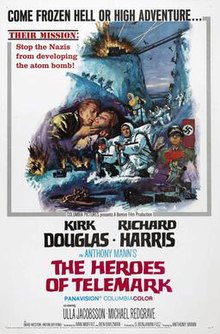|
The Heroes of Telemark
The Heroes of Telemark is a 1965 British war film directed by Anthony Mann based on the true story of the Norwegian heavy water sabotage during the Second World War from Skis Against the Atom, the memoirs of Norwegian resistance soldier Knut Haukelid. The film stars Kirk Douglas as Dr. Rolf Pedersen and Richard Harris as Knut Straud, along with Ulla Jacobsson as Anna Pederson. It was filmed on location in Norway. PlotThe Norwegian resistance sabotage the Vemork Norsk Hydro plant in the town of Rjukan in the county of Telemark, Norway, which the Nazis are using to produce heavy water, which could be used in the manufacture of an atomic bomb. Rolf Pedersen, a Norwegian physics professor, who, though originally content to wait out the war, is soon pulled into the struggle by local resistance leader Knut Straud (based on Knut Haukelid), portrayed by Richard Harris. Rolf's ex-wife Anna also becomes involved in the effort, and her relationship with Rolf reignites. Rolf and Knut sneak out of Norway on a passenger steamship to Britain that they hijack so they can deliver microfilmed plans of the hydroelectric plant to the British, who are impressed by the information. Then the two return to Norway by parachute to plan a commando raid against the plant. When a British plane carrying a force of Royal Engineers to undertake the raid is shot down over Norway by the Germans, Pedersen and Straud lead a small force of Norwegian saboteurs into the plant. The raid is successful, but the Germans quickly replace and repair the equipment. A Quisling (traitor) saboteur worms his way into the resistance group, after they debate whether to shoot him or not. He ends up escaping and betraying them, so that a German plane blows up their safe house. When the Nazis and the saboteur pursue Rolf and Knut, Rolf and the saboteur end up alone, and Rolf kills him. When Rolf and Knut learn of German plans to ship steel drums of heavy water to Germany, they sabotage the ferry carrying the drums, and it sinks in the deepest part of a fjord. Rolf himself ends up on the ferry when he sees a resistance comrade's widow and her young child getting aboard; Rolf improvises a "game" whereby all the children on board practise with lifejackets at the stern of the ship. Thus, when the ferry sinks, the children, and Rolf and the widow, are able to escape. Knut and Anna, in a small boat, come and help rescue passengers. Cast
ProductionKnut Haukelid wrote a memoir of the attack called Skis Against the Atom published in 1954.[4] John Drummond wrote a novel based on the same story called But for These Men. Both books formed the basis of the screenplay. The film was originally announced in 1963.[5] It was made by Benton Film Productions, a company of director Anthony Mann and producer S. Benjamin Fisz. Financing came from America's Allied Artists and Britain's J Arthur Rank Productions. Besides this sequence, the raids (Operations Grouse, Freshman and Gunnerside) and the final attack are filmed on-site, with mountainous and snowy Norwegian locations serving as a backdrop. Scenes early in the film when the main characters escape from occupied Norway were filmed around Poole and Hamworthy in Dorset, with the former Channel Islands ship TSS Roebuck playing the role of the hijacked steamer. SF Ammonia was used to represent the train ferry SF Hydro in the final fjord scenes. The movie was originally titled The Unknown Battle and was to have starred Stephen Boyd and Elke Sommer and be written by Ben Barzman.[6] Later, Anthony Perkins was announced as a star, though he withdrew.[7] Eventually Kirk Douglas signed as the lead.[8] Cliff Robertson was mentioned as a possible co-star before Richard Harris came on board.[9] "I hear they are spending five million dollars, so it's got to be spectacular and that means more fiction and less fact", said Haukelid during filming.[1] Stephen Boyd later sued Mann for half a million dollars when funding for the initial project fell apart in early 1964. "I missed out on four good roles and plenty of money when he signed me without financial backing and then dropped the project", said Boyd later. "He asked me again later but I'd made other commitments, so Kirk Douglas and Richard Harris made it under another title."[10] Differences from realityUnlike the scenes in the film, the saboteurs had already left the area when the bomb exploded.[citation needed] Also omitted is the death of 18 Norwegian civilians in the sinking and the rescue efforts of local fishermen.[citation needed] ReceptionIt was amongst the 15 most popular films at the British box office in 1966.[11] The film has a 67% rating in Rotten Tomatoes, based on six reviews, with an average rating of 6.10/10.[12] Other versionsRay Mears made a documentary called The Real Heroes of Telemark. Despite mainly sticking to the factual evidence, some scenes in the documentary, like the film, were partly dramatised, focusing more on the survival skills involved in the operation. The same story was also covered in the 1948 Franco-Norwegian film Kampen om tungtvannet (La bataille de l'eau lourde — "The battle for heavy water"). Quite faithful to the real events, it even had many of the original Norwegian commandos starring as themselves. In 2015, the Norwegian Broadcasting Corporation showed a TV series called Kampen om tungtvannet (also known as The Heavy Water War or The Saboteurs) based on the events. See alsoReferences
External links |
||||||||||||||||||||||||||||||||||||
